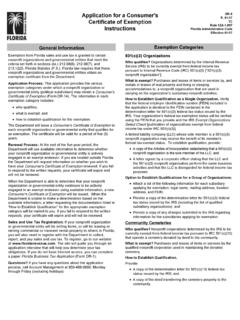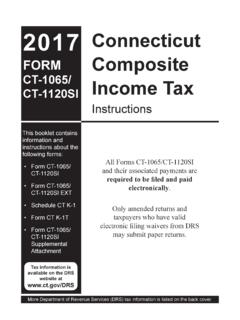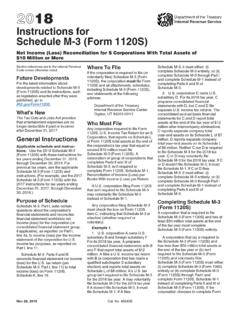Transcription of S Corporations and F Reorganizations - San …
1 4 THE M&A TAX REPORT could evidently not claim a credit for any overpaid employment tax. Amending Prior Year ReturnsAmending a prior year return might seem to be the cleanest method to effectuate a bonus repayment. Generally, however, taxpayers can amend returns only within three years of filing the original return, or within two years of the date the tax was paid, whichever is later. Plus, amending a prior year return is generally allowed only to correct a mistake. Here, an amendment would not seek to correct a mistake, but would be changing the nature of the prior bonus transaction, netting it with the current repayment. Since the executive originally received the income under a claim of right, and without restriction as to its disposition, the taxpayer probably cannot later amend his original return.
2 Salary Reduction?Another alternative may be for the company to reduce the executive s current year salary. Of course, this works only for current employees, and many repaying persons are former employees. Plus, it isn t clear if an offset would achieve the same public relations or legal effect. Although, there does not appear to be any direct authority disallowing this arrangement, the IRS might argue that the two transactions (a current salary and a repayment of a prior year s salary) must be reported may see more such pay give-backs, in settlements of lawsuits and in early-stage investigations, where issues of the voluntary versus mandatory character of the repayment are likely to outrage and litigation are probably far more frightening than the prospect of losing a tax deduction for returning compensation.
3 Nevertheless, the tax cost to this kind of mismatch may add enormously to the executive s overall cost of a payback. Moreover, this is the kind of tax issue that one can imagine an otherwise sophisticated client not comprehending. The headaches an executive would face on having to give back money plus face tax disadvantages will be palpable. S Corporations and F ReorganizationsBy Robert W. Wood Wood & Porter San FranciscoF Reorganizations can be very simple, including a mere charge in identity, form or place of organization, however affected. As but one example, if you have a California corporation and you want a Delaware corporation instead, an F reorganization can be as simple as forming a new Delaware corporation , and merging the California corporation into it. In that way, a single organization disincorporates in California and reincorporates in Delaware.
4 Internal Revenue Code Section ( Code Sec. ) 381 provides that in the case of an F reorganization, the acquiring company is treated just as the transferor corporation would have been treated had there been no reorganization. [Reg. (b)-1(a)(2).] Where an S corporation is involved, there can be wrinkles. Given the value of an S election these days (indeed, any time since the repeal of the General Utilities Doctrine in 1986), it pays to pay attention to these wrinkles. Fortunately, the IRS long ago concluded that where an S corporation merges into a newly formed corporation in an F reorganization, with the newly formed, surviving corporation also meeting the requirements of an S corporation , the reorganization does not terminate the S election. [See Rev. Rul. 64-250, 1964-2 CB 333.]QSubsIt is axiomatic that an S corporation cannot have a corporate shareholder.
5 [See Code Sec. 1361(b)(1)(B).] Generally speaking, that means a subsidiary cannot be an S corporation . However, an S corporation is allowed to have an S corporation subsidiary if it owns 100 percent of the subsidiary s stock. Not only must there be 100-percent ownership, but the subsidiary must not otherwise be ineligible for S status, and the S corporation parent must make an election to treat the subsidiary as a qualified Subchapter THE M&A TAX REPORT5S subsidiary (QSub). [See Code Sec. 1361(b)(3)(B).] This QSub election is made by the parent on Form doing this, the QSub will not be treated as a separate corporation for federal income tax purposes. Instead, much like a check-the-box election to be treated as a disregarded entity, the assets, liabilities and items of income, deductions and credits of the QSub will be treated as those of the parent.
6 [Code Sec. 1361(b)(3)(A).]S and FHow does all of this fit into the practice of otherwise simple F Reorganizations involving S Corporations ? Read on. The IRS ruled decades ago that an acquiring corporation in an F reorganization should use the EIN of the transferor corporation . [See Rev. Rul. 73-526, 1973-2 CB 404.] Of course, QSubs came into existence after that. Moreover, Code Sec. 1361 now provides that QSubs are generally not disregarded for purposes of information returns and for certain other purposes. The regulations detail the fact that a QSub is treated as a separate corporation for employment tax and related reporting requirements. This rule is effective for wages paid on or after January 1, 2009. [See Reg. (a)(7).]Furthermore, the regulations state that a QSub is treated as a separate corporation for purposes of certain excise taxes.
7 This rule is effective for periods commencing January 1, 2008, and thereafter. [See Reg. 1361-4(a)(8).]Does Your S Election Terminate?The almost imponderably bad thing you want to avoid with an F reorganization, of course, is any break in continuity. I m using the term continuity here in a colloquial sense, not a continuity of interest or continuity of ownership sense. Put simply, you don t want your S election to terminate. A recent revenue ruling looks at the high stakes question whether an S election terminates, and what impact which EIN you use will have. Rev. Rul. 2008-18, IRB 2008-13, Mar. 31, 2008, examines two Situation 1, B is an individual who owns all of the stock of an S corporation . The Individual forms NewCo, contributing all of the Y stock to NewCo. We re told that NewCo meets the requirements to qualify as an S corporation , and timely elects to treat Y as a QSub.
8 In year 2, NewCo sells a one-percent interest in Y to a third on Rev. Rul. 64-250, the IRS says that Y s original S election does not terminate. It simply continues on for NewCo. NewCo must obtain a new EIN. Y, now a subsidiary , must keep the old EIN. We re told that Y, as a QSub, must use this historic EIN any time it needs to keep track of its separate entity status for federal tax purposes (and we are reminded that would include employment and excise taxes). Furthermore, when NewCo later sells a one-percent interest in Y to a third party, that, of course, terminates Y s QSub election. Thereafter, Y must use the historic EIN following that QSub election the second situation, we are presented with C, an individual who owns all of the stock of an S corporation called Z.
9 Z s EIN is 33-3333333. Z forms NewCo, which in term forms MergeCo. MergeCo them merges with and into Z, with Z surviving. C receives solely NewCo stock in exchange for his Z stock. NewCo qualifies as an S corporation , and timely elects to treat Z as a , again relying on Rev. Rul. 64-250, we re told that Z s original S election does not terminate, but instead continues on for NewCo. However, NewCo must obtain a new EIN. Z, on the other hand, must retain its historic EIN, even though a QSub election is made for Z. As a QSub, Z will need its original EIN only when being treated as a separate entity for federal tax purposes (including employment and certain taxes).Effective DatesRev. Rul. 2008-18 applies to F Reorganizations occurring on or after January 1, 2009, though in some cases, taxpayers may invoke it for certain 2008 anyone who has ever ended up with several EINs, or the wrong EIN in the wrong entity knows, such seeming banalities can have momentous tax consequences.
10








